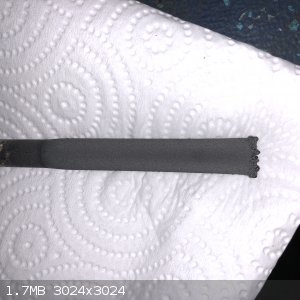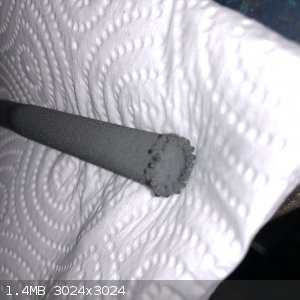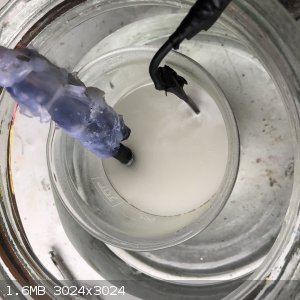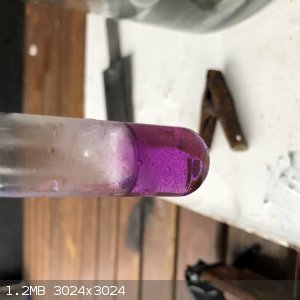| Pages:
1
2
3
4 |
Simoski
Hazard to Self
 
Posts: 82
Registered: 24-12-2017
Location: Johannesburg South Africa
Member Is Offline
Mood: No Mood
|
|
Does the beta crystal structure resemble obsidian?
|
|
|
Simoski
Hazard to Self
 
Posts: 82
Registered: 24-12-2017
Location: Johannesburg South Africa
Member Is Offline
Mood: No Mood
|
|
Has anyone attempted to electro-deposit PbO2 at elevated and reduced pressure? If not, reply if you have any ideas on how to build a machine that can.
Let's build the most inert anode ever!
[Edited on 28-12-2017 by Simoski]
|
|
|
ecos
Hazard to Others
  
Posts: 464
Registered: 6-3-2014
Member Is Offline
Mood: Learning !
|
|
i tried a lot and failed. it is not easy to electro-deposit PbO2 on anything !
complicated setup and nasty chemicals.
spend some money and by an anode !
|
|
|
Laboratory of Liptakov
International Hazard
    
Posts: 1335
Registered: 2-9-2014
Location: Technion Haifa
Member Is Offline
Mood: cool.gif
|
|
Ecos has right. Buy anode is much more easily. And here it seems, that is possible go to from NaCl on NaClO4 in one step. Even without adding any next
inhibitors etc. https://www.youtube.com/watch?v=VQb4jLp-Vuc with PbO2 anode of course.
Development of primarily - secondary substances CHP (2015) Lithex (2022) Brightelite (2023) Nitrocelite (2024)
|
|
|
NeonPulse
Hazard to Others
  
Posts: 417
Registered: 29-6-2013
Location: The other end of the internet.
Member Is Offline
Mood: Isolated from Reality! For Real this time....
|
|
Ok. Had a success on making one of the anodes. Basically used the setup described in the first post on this thread and with help from the video listed
in that post. I used a 100mm by 8mm diameter graphite rod as the substrate and firstly sanded it shiny smooth with 1200 grit sandpaper. Next it was
thoroughly wiped down with acetone and given a pre treatment electrolysis in NaOH a 10% solution with a stainless steel cathode for about 30 mins.
After this it was submerged in a 5% HNO3 solution for another 15-20mins and washed with water. Next the graphite was left to dry overnight.
For plating the substrate I made a solution of 400mls using 50g of Lead nitrate and 10g of copper nitrate, this was acidified to PH of 1 with diluted
HNO3. The rod was attached to a small 12v motor with a speed control PWM device added. This was done by sliding a brass couple onto the motor shaft
and slipping a bit of hose over it in which the graphite rod was inserted. Some copper foil was wrapped around the hose with a glob of silver
conductive glue to make contact with the rod to allow a sliding contact to the power supply. There was a bit of copper wire as the cathode. The
substrate was immersed and the motor started along with the power supply which was set to around 6v and 2a and was kept playing fro just over 1 hour.
The results were pretty good. The coating looks sturdy and does not rub off easily. There’s no pitting anywhere with a few dendritic growths on the
base. The added weight to the anode totals 10.6g. A couple more of these and we should be good to go for a perchlorate cell. I do have a couple of
salvaged MMO anodes from a pool chlorination setup I would love to attempt to plate. Possibly under ultrasonic vibrations to move the bubbles away. I
got them cheap so they are expendable.
 
|
|
|
markx
National Hazard
   
Posts: 645
Registered: 7-8-2003
Location: Northern kingdom
Member Is Offline
Mood: Very Jolly
|
|
This looks very sturdy, Neonpulse! Would love to hear how they hold up in perchlorate cell conditions. My thin coatings were surprisingly fragile in
terms of durability and tended to flake off.
Exact science is a figment of imagination.......
|
|
|
XeonTheMGPony
International Hazard
    
Posts: 1636
Registered: 5-1-2016
Member Is Offline
Mood: No Mood
|
|
use a pumped bath, all the motor does is stir the solution, using a cheap systolic pump or other type you move the solution rather then electrode.
for screen you can cut a section of pipe that make the required flow geometry to wash off any bubble adjust flow volume to ensure effective bubble
removal but not so fast to disturb plating
|
|
|
NeonPulse
Hazard to Others
  
Posts: 417
Registered: 29-6-2013
Location: The other end of the internet.
Member Is Offline
Mood: Isolated from Reality! For Real this time....
|
|
Ok a bit of an update. I recently made 4 GSLDA’s for my perchlorate project and they looked solid, like they would work. Well looks are secondary to
performance..... three of the anodes failed. I firstly put three together on a Ti connection and it was going well for a few hours after running the
cell for a little I was dismayed to see a pile of Lead dioxide at the bottom of the cell. Shortly after the liquor began to take on an obvious brown
colour of graphite destruction. Doh. The next day after filtering the liquid I tried again with two more anodes - one failed in less than 15 mins and
this is not surprising as it was the one that looked the worst and I called a fail. Luckily the last one is actually holding up. It was one of the 3
from the first anode I tried. It has been going for hours with no problems and it is forming perchlorate. The cell is running at 5v 14a and it’s
plodding along fine. There is very little erosion as I can see tiny amount of brown particles after stopping the cell for the night but it is working.
I tested some of the cell liquid ice cold with methylene blue and it turn the desired purple with purple precipitation.


|
|
|
Laboratory of Liptakov
International Hazard
    
Posts: 1335
Registered: 2-9-2014
Location: Technion Haifa
Member Is Offline
Mood: cool.gif
|
|
Very important information for anyone. This shows, that anode is not some easy manufacture. Never. However x ClO4 is great result.
You info are key info on the field an heavy xxClO4 production. Hat down...
Development of primarily - secondary substances CHP (2015) Lithex (2022) Brightelite (2023) Nitrocelite (2024)
|
|
|
yobbo II
National Hazard
   
Posts: 709
Registered: 28-3-2016
Member Is Offline
Mood: No Mood
|
|
It's dead easy to make graphite substrate lead dioxide anodes. It is real hard to make one that will last for any appreciable length of time.
As the professionals stated a long time ago.
At least three mm thick coating (better to have five).
Perfect coating with no holes either of the visible kind or the invisible kind.
This requires a proper set up and a large quantity of chemicals in relation to the total amount of lead dioxide that you are going to deposit.
and some luck IMO!
Most end up with lots of work and an anode that lasted half (or less) of a batch of perk.
Yob
|
|
|
symboom
International Hazard
    
Posts: 1143
Registered: 11-11-2010
Location: Wrongplanet
Member Is Offline
Mood: Doing science while it is still legal since 2010
|
|
Problems with lead dioxide from flaking off
https://www.google.com/amp/www.instructables.com/id/Make-Con...
Would this work it conductive glue it uses charcoal powder
|
|
|
markx
National Hazard
   
Posts: 645
Registered: 7-8-2003
Location: Northern kingdom
Member Is Offline
Mood: Very Jolly
|
|
I think this glue approach will hardly work under perchlorate synthesis conditions. Such conductive coatings can be used as the initial layer in
plating operations when using nonconductive substrates as the cathode (plating on plastic details e.g.) I used a silver based conductive paint when I
was working on thick platings to grow moulds for forming plastic details with intricate geometry. Basically the plastic detail was coated with
conductive paint and then a thick coating of Cu or Ni plated over that to create an exact replica for forming further details made out of plastic.
That was way back during the years of my bachelor studies in material science department.
Seemingly the only way to a more or less durable anode is to create a homogenous and thick coating of PbO2, as already mentioned before (but that is
no trivial task and reproducibility seems poor).
Exact science is a figment of imagination.......
|
|
|
| Pages:
1
2
3
4 |